Organizers - Study guides, Revision notes & Summaries
Looking for the best study guides, study notes and summaries about Organizers? On this page you'll find 1535 study documents about Organizers.
Page 4 out of 1.535 results
Sort by
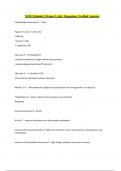
-
N5315 Module 3 (Exam 2) Adv. Organizers Verified Answers
- Exam (elaborations) • 3 pages • 2024
- Available in package deal
-
- £7.31
- + learn more
N5315 Module 3 (Exam 2) Adv. Organizers Verified Answers Cell-Mediated Immunity ️T-cells Types of T cells ️-CD4 cells -CD8 cells -memory T cells -T regulatory cells CD4 cells ️-Th/Thelper/T4 -release lymphokines to begin inflammatory process -mediate delayed sensitivity (TB skin test) CD8 cells ️-T cells/Killer T/T8 -kill viruses by releasing cytotoxic chemicals Memory T ️-Remember the antigen to respond faster and stronger after 1st exposure T Regulatory ️-slow or stop i...
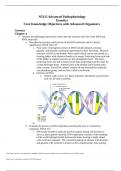
-
N5315 Advanced Pathophysiology Genetics Core Knowledge Objectives with Advanced Organizers
- Exam (elaborations) • 7 pages • 2023
-
- £8.08
- + learn more
N5315 Advanced Pathophysiology Genetics Core Knowledge Objectives with Advanced Organizers Genetics Chapter 4 1. Analyze the pathological processes which alter the structure and role of the DNA and RNA molecules. a. Describe the structure and function of the DNA molecule and its clinical significance. PAGE 136-137 i. Four types of nitrogenous bases of DNA include adenine, cytosine, guanine, and thymine commonly represented as their first letter. Physical structure of DNA is the double...
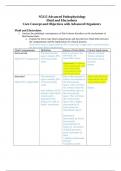
-
N5315 Advanced Pathophysiology Fluid and Electrolytes Core Concept and Objectives with Advanced Organizers
- Exam (elaborations) • 14 pages • 2024
-
- £6.54
- + learn more
N5315 Advanced Pathophysiology Fluid and Electrolytes Core Concept and Objectives with Advanced Organizers Fluid and Electrolytes 1. Analyze the pathologic consequences of fluid volume disorders on the mechanisms of fluid homeostasis. a. Explain the three main fluid compartments and describe how fluid shifts between the compartments and the implications for clinical practice. Total body water is approximately 60% of the body weight and is spread between the three main fluid compartments...
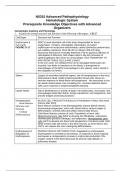
-
N5315 Advanced Pathophysiology Hematologic System Prerequisite Knowledge Objectives with Advanced Organizers
- Exam (elaborations) • 10 pages • 2023
-
- £10.39
- + learn more
Hematologic Anatomy and Physiology 1. Analyze the normal structure and function of the following cells/organs. CH 27 Cell/Organ Structure and Function Erythrocytes & Iron Cycle FIGURE 27-17 (RBC’s) most abundant cell of the body. Responsible for tissue oxygenation. Contains: Hemoglobin, Electrolytes, [A mature erythrocyte=no nucleus/no mitochondria, cannot synthesize protein/carry out oxidative reactions]. Short life d//t no mitosis=100-120 days. Biconcave disk/can be reversibly defo...
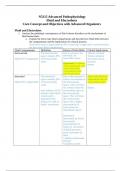
-
N5315 Advanced Pathophysiology Fluid and Electrolytes Core Concept and Objectives with Advanced Organizers
- Exam (elaborations) • 14 pages • 2024
-
- £6.92
- + learn more
N5315 Advanced Pathophysiology Fluid and Electrolytes Core Concept and Objectives with Advanced Organizers Fluid and Electrolytes 1. Analyze the pathologic consequences of fluid volume disorders on the mechanisms of fluid homeostasis. a. Explain the three main fluid compartments and describe how fluid shifts between the compartments and the implications for clinical practice. Total body water is approximately 60% of the body weight and is spread between the three main fluid compartments...
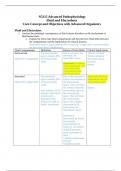
-
module2sg N5315 Advanced Pathophysiology Fluid and Electrolytes Core Concept and Objectives with Advanced Organizers
- Exam (elaborations) • 14 pages • 2024
-
- £6.92
- + learn more
N5315 Advanced Pathophysiology Fluid and Electrolytes Core Concept and Objectives with Advanced Organizers Fluid and Electrolytes 1. Analyze the pathologic consequences of fluid volume disorders on the mechanisms of fluid homeostasis. a. Explain the three main fluid compartments and describe how fluid shifts between the compartments and the implications for clinical practice. Total body water is approximately 60% of the body weight and is spread between the three main fluid compartments...

-
WGU D094 Unit Reviews and Graphic Organizers Questions and Answers 2023
- Exam (elaborations) • 15 pages • 2023
- Available in package deal
-
- £15.78
- + learn more
WGU D094 Unit Reviews and Graphic Organizers Questions and Answers 2023 When recess is called, two boys slip on their hoodies, and a little concentration zip them up. They then run onto the playground where they draw stick figures with chalk. What physical development stage describes these students? early childhood True or False, A second grade student tells his teacher that he is being bullied on the playground by other children. The student is attempting to meet his physiological need...
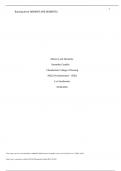
-
N5315 Advanced Pathophysiology Altered Cellular Function and Cancer Module Objectives with Advanced Organizers study guide
- Exam (elaborations) • 4 pages • 2023
-
- £9.62
- + learn more
N5315 Advanced Pathophysiology Altered Cellular Function and Cancer Module Objectives with Advanced Organizers Cellular Adaptation Patterns 1. Analyze the differences between cellular adaptation patterns. a. Differentiate between the etiology and the pathophysiology of atrophy, hypertrophy, hyperplasia, dysplasia, and metaplasia and identify an example
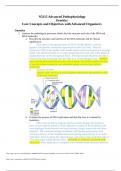
-
N5315 Advanced Pathophysiology Genetics Core Concepts and Objectives with Advanced Organizers
- Exam (elaborations) • 9 pages • 2024
-
- £6.92
- + learn more
N5315 Advanced Pathophysiology Genetics Core Concepts and Objectives with Advanced Organizers Genetics 1. Analyze the pathological processes which alter the structure and role of the DNA and RNA molecules. a. Describe the structure and function of the DNA molecule and its clinical significance. i. Four types of nitrogenous bases of DNA include adenine, cytosine, guanine, and thymine commonly represented as their first letter. Physical structure of DNA is the double- helix model which c...

-
N5315 Advanced Pathophysiology Altered Cellular Function and Cancer Module Core Concepts and Objectives with Advanced Organizers
- Exam (elaborations) • 24 pages • 2023
-
- £16.53
- + learn more
N5315 Advanced Pathophysiology Altered Cellular Function and Cancer Module Core Concepts and Objectives with Advanced Organizers

That summary you just bought made someone very happy. Also get paid weekly? Sell your revision notes on Stuvia! Discover all about earning on Stuvia


